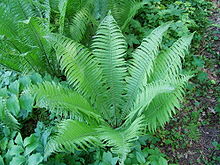Leaf rosette


In plants, a leaf rosette is a section of the stem on which the leaves are densely packed. This is due to the failure of the internodes to stretch . The stem axis in this section is thus compressed. Leaf rosettes are usually formed on the stem base, such plants are called rosette plants .
Leaf rosettes are not limited to the stem base, however. A rosette has at least three (rarely two) leaves that form a pseudo whorl, as is the case with wood anemones ( Anemone nemorosa ). Usually, however, there are significantly more leaves. The leaf position can be alternate or whorled. If the rosette is basal, it is called the base rosette (for rosette plants). The rosette is rarely found on the stem, for example in the Turkish league ( Lilium martagon ), or on the side in the armpits of stem leaves.
Leaf rosettes are formed by some rhizome plants, but more often by cushion plants and many annual and biennial plants .
As a rosette leaf arrangement is referred to in a rosette or similar to a rosette.
supporting documents
- ↑ a b Gerhard Wagenitz : Dictionary of Botany. The terms in their historical context. 2nd, expanded edition. Spektrum Akademischer Verlag, Heidelberg / Berlin 2003, ISBN 3-8274-1398-2 , p. 47.
- ^ A b Manfred A. Fischer , Karl Oswald, Wolfgang Adler: Excursion flora for Austria, Liechtenstein and South Tyrol. 3rd, improved edition. State of Upper Austria, Biology Center of the Upper Austrian State Museums, Linz 2008, ISBN 978-3-85474-187-9 , p. 64.
- ^ Peter Sitte , Elmar Weiler , Joachim W. Kadereit , Andreas Bresinsky , Christian Körner : Textbook of botany for universities. Founded by E. Strasburger. Spektrum Akademischer Verlag, Heidelberg 2002 (35th edition) ISBN 3-8274-1010-X , pp. 155f.